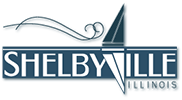The Shelbyville Chautauqua Auditorium
A Historical and Architectural Icon
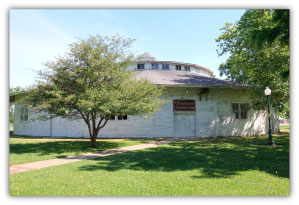 The Chautauqua Auditorium, built in 1903, is a large historic icosagonal (20-sided) wooden Chautauqua meeting hall located in the center of Forest Park on North East 9th Street.
The Chautauqua Auditorium, built in 1903, is a large historic icosagonal (20-sided) wooden Chautauqua meeting hall located in the center of Forest Park on North East 9th Street.
Highly popular in the late 19th and early 20th centuries, Chautauqua was an adult education movement in the United States. Chautauqua assemblies broadened and spread throughout rural America until the mid-1920s. The Chautauqua brought entertainment and culture for the whole neighborhood, with instructors, teachers, speakers, musicians, preachers and performers of the day.
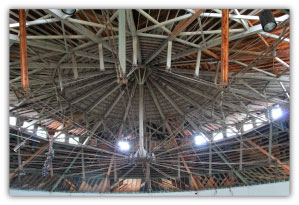 Organized in 1874, the first Chautauqua, the New York City Chautauqua Assembly, was established at a campsite on the coasts of Chautauqua Lake in New York State. Later becoming known ad the Chautauqua Organization, it was originally called the “Mother Chautauqua”, because numerous independent, or “Daughter” Chautauquas were established under the same fashion.
Organized in 1874, the first Chautauqua, the New York City Chautauqua Assembly, was established at a campsite on the coasts of Chautauqua Lake in New York State. Later becoming known ad the Chautauqua Organization, it was originally called the “Mother Chautauqua”, because numerous independent, or “Daughter” Chautauquas were established under the same fashion.
At the height of the Chautauqua movement in the 1920s, a number of hundred of these existed, but their numbers are decreasing. Independent Chautauqua were normally built in an attractive semi-rural location a brief distance outside an established town with good rail service.
Established in 1901, the Shelbyville Chautauqua Association was developed and the following year, the Association voted to construct a permanent structure just as many other Chautauqua hosting areas had done. It was clear that in the early 1900’s, the Chautauqua Auditorium was the center for hometown entertainment and social events for Shelbyville and its bordering communities.
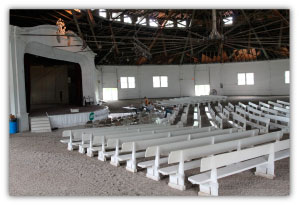 The Chautauqua Auditorium was based on a similar structure built in Dixon, Illinois and designed by Architect Morrison H, Vail. The project took eight months to build at a cost of approximately $7,500.
The Chautauqua Auditorium was based on a similar structure built in Dixon, Illinois and designed by Architect Morrison H, Vail. The project took eight months to build at a cost of approximately $7,500.
The aesthetic of the structure was intended to resemble big outdoor tents, which display the early beginnings of the Chautauqua movement. The structure features a series of 40 operable clerestory windows, 18 large windows located on the main floor level and ten big upright overhead doors. The framework is made up of twenty trusses built from multi-ply wood top chords, double steel tie-rod bottom chords and strong timber web construction materials. The trusses bear upon timber columns located at each end of the walls that comprise the twenty-sided framework. Each column is supported on foundations of 4′ x 4′ flared concrete footings and is anchored to the footings by wrought iron anchors. The lateral support for the structure is comprised of 2×6 shear walls and horizontal tongue and groove plank home siding. The interior floor area of the building is 15,000 square feet and the roof is supported by an unique series of beams and supports in the ceiling. The clear span of the framework is 150 feet, which means there are no columns anywhere in the building to obstruct the view of the stage.
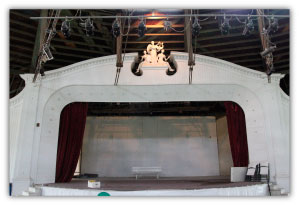 The building also has a huge 36’x36′ stage featuring Grecian statues by local artist Robert Root that sit atop the stage representing Art, Music and Drama. The Auditorium also had an orchestra pit at one time that could seat up to twenty musicians. The seating is arranged in a bowl-shape similar to many modern day auditoriums.
The building also has a huge 36’x36′ stage featuring Grecian statues by local artist Robert Root that sit atop the stage representing Art, Music and Drama. The Auditorium also had an orchestra pit at one time that could seat up to twenty musicians. The seating is arranged in a bowl-shape similar to many modern day auditoriums.
The Shelbyville Chautauqua was one of many independent Chautauquas across the country. Even so, it has been a stop for many famous speakers including William Howard Taft, William Jennings Bryan, Billy Sunday, Reverend Sam Jones, and Carry Nation among others. Other past performers at the Chautauqua Auditorium include Dolly Parton, Alison Krauss, REO Speedwagon and Barbara Mandrell.
It has been used for many local entertainment purposes purposes in recent years, including music concerts, talent shows, meetings, haunted houses, weddings and serves as the centerpiece for the Festival of Lights during the Christmas Season.
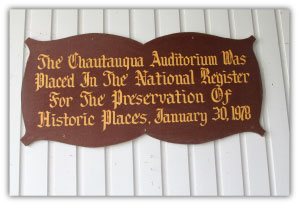 On January 30, 1978, it was added to the National Register of Historic Places and in 2009, Landmarks Illinois declared it one of the 10 most endangered historic places in Illinois.
On January 30, 1978, it was added to the National Register of Historic Places and in 2009, Landmarks Illinois declared it one of the 10 most endangered historic places in Illinois.
The Chautauqua Auditorium is no doubt a magnificent building, but has suffered through many years of weather, deterioration and neglect. Much of the original structure is still in tact and performing well. The building is in need of extensive repairs which are estimated to cost $1.75 million and to be completed in a four-phase restoration project. The city of Shelbyville which owns the auditorium and is currently working closely with the Chautauqua Auditorium Preservation Committee to find ways to bring the building back to shape.
The building is currently maintained by the Shelbyville parks and grounds crews.
